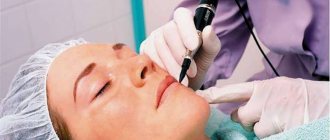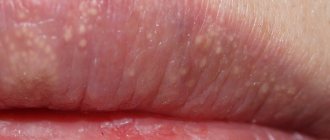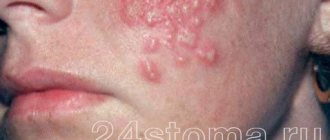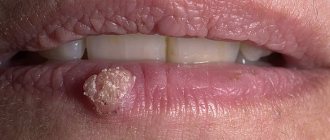Fordyce granules
Fordyce granules are hyperplastic sebaceous glands that tend to form in those areas of the body where the skin is thinnest and most delicate. Most often they are localized on the mucous membranes of the oral cavity (in particular on the cheeks), on the lips, in the groin, directly on the genitals and on the nipples. Such changes in the sebaceous glands were first described by the American dermatologist and syphilidologist John Addison Fordyce back in 1896. Hence the name that has now become generally accepted for them - Fordyce granules. Formations are considered one of the variants of the physiological norm, since they are: completely benign; do not harm health; are not accompanied by unpleasant symptoms; are not transmitted during sexual contact or any other way. That is why patients turn to specialized medical institutions only in cases where visible sebaceous glands represent a serious cosmetic defect and become a reason for a person’s dissatisfaction with their appearance. The exact reasons that provoke changes in the sebaceous glands have not been identified at the moment. However, most doctors, based on the results of pathomorphological studies of tissues, believe that the prerequisite for the occurrence of cysts are various types of congenital disorders of the development of the sebaceous glands, leading to their displacement into the upper layer of the skin or to a change in their normal location (the location of the sebaceous glands in the area of the border of the lips is considered abnormal , on the mucous membranes of the oral cavity, etc.). Another cause of Fordyce granules is considered to be hyperplasia of the excretory ducts of the sebaceous glands, which provokes the appearance of cystic formations in them. Simply put, Fordyce granules develop in people who have excessive narrowing or blockage of the excretory ducts of the glands, accompanied by the accumulation of secretions (sebum) in them. Sebaceous gland cysts first appear in humans during adolescence, when the process of puberty begins, that is, approximately in the range from 13 to 17 years. Thus, it can be assumed that the process of formation of Fordyce granules proceeds in accordance with the following algorithm: during the period of intrauterine development in the fetus, for one reason or another, the formation of the sebaceous glands is disrupted; when the child reaches a certain age, under the influence of steroid hormones that are produced by the sex glands (the so-called androgen hormones), the glands begin to increase in size and actively produce sebum, which results in their visualization.
Characteristic features of Fordyce granules. Externally, sebaceous gland cysts resemble small nodules (or papules) the size of a millet grain. As a rule, such rashes are numerous, widespread and not accompanied by pain (either at rest or when pressing on them). When pressing on the formation, in some cases a very small amount of liquid may be released from it, having a white-yellow tint and a rather thick consistency. However, more often than not, attempts to squeeze the contents out of Fordyce granules end in pinpoint bleeding and the development of hematomas in the area of skin surrounding the damaged papule.
Doctors are categorical in their prohibitions on self-removal of Fordyce granules, since this, firstly, is very painful, and secondly, provokes inflammatory processes and scarring of the skin. This is especially true in cases where the cysts are localized in the lip border area. Fordyce granules on the lips in the vast majority of cases (up to 90%) occur in women. This type of Fordyce granules occurs as a result of damage to the apocrine sweat glands, which are somewhat associated with the genitourinary system.
Treatment of Fordyce granules. Unfortunately, there are currently no effective methods for treating Fordyce granules. The use of jojoba oil and vitamin A is recommended as a means to inhibit further development of the process. These products help remove Fordyce granules that are already present and prevent the formation of new ones. Such drugs can act mainly on fresh cysts.
The main methods of removal are electrocoagulation or cryotherapy. Treatment of large Fordyce granules, as well as formations classified as old, is carried out through their surgical removal. The decision on the possible removal of certain elements is made by the attending physician. In this case, the skin over the papule is opened, the wen itself is peeled off, and the bleeding is stopped using an electrocoagulant. The edges of the operated area are sutured with special materials.
Pustovoitova E.V.
Treatment of white spots
If white spots appear on the genitals, including the labia, then this is a direct indication for examination and comprehensive treatment of the patient.
Women, when problems appear on the labia, do not always have a clear idea of where to go to get diagnosed and take all the necessary tests.
Which doctor deals with these problems?
As a rule, it is better for a woman to visit an examination room at a local clinic or make an appointment with a gynecologist.
Depending on the results obtained, the patient will be treated by a gynecologist, dermatovenerologist, allergist, endocrinologist or oncologist.
Timely diagnosis carried out by a specialist and tests that will need to be taken to find out the cause of the disease play a decisive role in the effectiveness of treatment.
How treatment will proceed depends on the cause of the disease.
Drug therapy is used, and in some cases surgery may be necessary.
- If the appearance of rashes is caused by ignoring the rules of personal hygiene, then it will be enough to follow them with the mandatory inclusion of water procedures and the use of hygiene products containing antiseptic components. If white spots appear as a result of heat rash, using baby powder with zinc will be enough.
- If the pathology has developed as a result of infection with pathogenic flora, then specific therapy will be required. A treatment regimen for the disease will be drawn up by a doctor based on the results of additional research and the stage of the disease.
- If there is no evidence of an infectious process, the doctor may recommend treating the rash with a disinfectant.
- If there is an allergy, then taking an antihistamine will be an ideal assistant in solving the problem; in case of hormonal imbalance, corticosteroids will come to the rescue, which should be prescribed by a specialist.
Regardless of the cause of the appearance of white spots in an intimate place, it is useful to take immunomodulators and vitamin-mineral complexes that will help the body cope with the pathology.
Diagnostics
Human papillomavirus infection (genital warts) is diagnosed in different ways, from visual examination of women and men to the most advanced examinations. CM "Global Clinic" has in its arsenal the latest techniques for determining the nature of condylomas. Diagnostic methods used by doctors:
- Clinical examination. Some types of diseases in women and men can be masked, taking the form of genital warts, so you need to have sufficient qualifications to differentiate different problems.
- Colposcopy is recommended for women, and urethroscopy for men.
- A smear will tell a lot about condylomas in women and their nature; this cytotest will also help to exclude cervical dysplasia.
- Histology.
- Diagnostics-PCR. This examination not only detects the presence of human papillomavirus, but also determines its type.
- Immunological research. It is used to detect antibodies to HPV in the blood.
All women and men affected by genital warts must be tested for infectious diseases of the genital area (syphilis, HIV, etc.)
Hygiene procedures for white spots on the labia
If the appearance of white spots on the labia is associated with poor hygiene, then washing the genitals daily with baby soap will help get rid of the problem.
Treatment procedures using antiseptic agents are usually prescribed by a gynecologist or dermatovenerologist.
In addition, some rules should be followed:
- when choosing underwear, make sure that it is made from natural fabrics;
- refuse to wear thong panties;
- Avoid using pads that contain fragrances, as they can cause rashes;
- use only a personal towel for hands, face and body;
- exclusion of hair removal and means for its implementation on the labia majora;
- When visiting a bathhouse or swimming pool, strictly observe hygiene rules.
Danger of neoplasms
Papillomas, condylomas and warts are benign formations, which under certain conditions can cause the following complications:
- Attachment of an infection that can develop as a result of accidental damage to a tumor or infection from the intestines.
- Degeneration into a malignant neoplasm – malignancy (malignancy).
- Attachment of a fungal infection. More often this concerns formations located in the pubic area.
Papillomas or condylomas in the genital area can be the reason for the impossibility of natural childbirth and an indication for cesarean section.
At-risk groups
In most cases, the disease affects people with weakened immune systems. In such a situation, the virus quickly penetrates healthy epithelial cells and actively divides in them, resulting in neoplasms. In addition, the following categories of people are at risk:
- Persons who have multiple sexual partners, and who do not use protection during sexual intercourse.
- People who do not follow the rules of personal hygiene.
- Persons with diseases of the genitourinary system.
Surgical methods for removing formations on the labia
In some cases, they resort to surgical removal of formations in an intimate place.
Indications for it are:
- the presence of papillomas and genital warts;
- fatty cysts;
- the appearance of neoplasms;
- presence of subcutaneous acne;
- molluscum contagiosum;
- furunculosis;
- inflammation of the Bartholin gland.
Most often, minimally invasive removal techniques are used: cryodestruction, laser therapy and radio wave excision of elements.
In exceptional cases, surgery can be performed using a scalpel.
- Laser therapy - this method is based on the use of a laser beam that evaporates the contents of the tumor. The technique is used to remove papillomas, cystic formations, and elements of rash caused by molluscum contagiosum.
- Radio wave therapy – the effect of radio waves is similar to the effect of a laser beam. The technology is used for excision of tumors.
- The use of liquid nitrogen (cryodestruction) is used to remove papillomas, molluscum contagiosum rashes, and condylomas. The method is rarely used due to the impossibility of controlling the depth of freezing of elements.
- Diathermocoagulation is a method that is very rarely used to excise tumors localized on the labia, since there is a high risk of burning surrounding tissues.
- Surgical intervention is used in case of a large size of the element or if its malignant nature is suspected.
After removal of the formation, a histological examination of the material is required, which is important to determine its benignity or malignancy.
Drug treatment of white spots on the genitals
- If there are rashes on the genitals, medications are used to help normalize the vaginal microflora. For this purpose, solutions, vaginal suppositories and vaginal tablets are used to help get rid of pathogenic microorganisms.
- In case of viral infection of the intimate area, tablets or injections are prescribed. The duration of drug treatment is determined by the doctor. On average it ranges from 10 days to two weeks. If herpetic rashes appear on the genitals, then ointments containing an antiviral active ingredient are used. If papillomas are present, they can be treated with keratolytics.
- For furunculosis, ointments with an osmotic effect are used, which accelerate the process of maturation and opening of the abscess.
- If an allergic rash occurs, you will need to identify the allergen that triggered its appearance and prevent skin contact with it. To relieve itching, your doctor may recommend taking an antihistamine.
3.Bartholinitis
Bartholinitis
- This is a consequence of blockage of the Bartholin gland. It is located at the entrance to the vagina and is involved in lubrication (moistening) of the external genitalia. During moments of sexual arousal, this process is especially intense. When a blockage of the gland duct occurs, a cyst is formed in which the produced secretion accumulates. If therapeutic measures are not taken, infection and cyst rupture often occur. This gives relief because the cavity is freed from accumulated secretory masses. However, the consequences of such spontaneous opening against the background of an abscess can be very dangerous. You should definitely consult a doctor at the first sign of a lump at the entrance to the vagina. If treatment is not carried out or the cyst does not open spontaneously, general malaise begins: the temperature rises, pain is felt when walking, and signs of acute infection appear. In the most difficult cases, the abscess can spread to the internal genital organs: the uterus, appendages.
Treatment of bartholinitis in uncomplicated cases by opening the cyst is not difficult. The operation is performed on an outpatient basis under local anesthesia. In more severe cases or when a postoperative relapse is established, a decision is made on bartholinectomy (complete removal of the Bartholin gland). This is a rather complicated operation, but in some cases it cannot be avoided.
About our clinic Chistye Prudy metro station Medintercom page!










